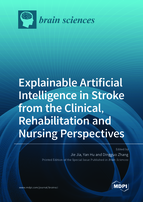Explainable Artificial Intelligence in Stroke from the Clinical, Rehabilitation and Nursing Perspectives
A special issue of Brain Sciences (ISSN 2076-3425). This special issue belongs to the section "Systems Neuroscience".
Deadline for manuscript submissions: closed (17 November 2022) | Viewed by 30636
Special Issue Editors
Interests: stroke; motor imagery; Brain Computer Interface; rehabilitation
Interests: cancer nursing; evidence-based nursing practice
Interests: human–machine interface; rehabilitation robotics; biomechatronics
Special Issues, Collections and Topics in MDPI journals
Special Issue Information
Dear Colleagues,
We are now preparing to launch a new Special Issue of Brain Sciences on "Explainable Artificial Intelligence in Stroke from the Clinical, Rehabilitation and Nursing Perspectives".
As we know, stroke is one of the world's leading causes of death, and the cruel aspect of stroke is that it leaves people with severe functional disability and/or cognitive impairment. Stroke has a great impact on economies worldwide, as it is estimated that about 10% of the male population and 8% of the female population are affected by it. Such people need personal help in their everyday life and must be materially supported by social services. With the advancement of medicine, artificial intelligence and new technologies have been developing rapidly and are gradually applied in diseases of the nervous system, increasingly helping diagnosis, treatment, rehabilitation and prognosis of disease.
This Special Issue aims to collect the latest researches on artificial intelligence and new technologies in stroke, including in the aspects of diagnosis, treatment, prognosis, rehabilitation and nursing.
We look forward to having your work to be a part of this collection.
In this Special Issue, original research articles and reviews are welcome. Research areas may include (but are not limited to) the following:
- Artificial intelligence in the diagnosis, treatment, rehabilitation and prognosis of
- New technology in the diagnosis, treatment, rehabilitation and prognosis of stroke.
Please let us know if you have any questions. We look forward to receiving your contributions.
The journal “Brain Sciences” (ISSN 2076-3425) is indexed in *Scopus* (CiteScore = 3.0) and *SCIE*—Web of Science (IF = 3.394), with citations available in *PubMed*, full-text archived in PubMed Central. Details on: https://0-www-mdpi-com.brum.beds.ac.uk/journal/brainsci
Prof. Dr. Jie Jia
Dr. Yan Hu
Dr. Dingguo Zhang
Guest Editors
Manuscript Submission Information
Manuscripts should be submitted online at www.mdpi.com by registering and logging in to this website. Once you are registered, click here to go to the submission form. Manuscripts can be submitted until the deadline. All submissions that pass pre-check are peer-reviewed. Accepted papers will be published continuously in the journal (as soon as accepted) and will be listed together on the special issue website. Research articles, review articles as well as short communications are invited. For planned papers, a title and short abstract (about 100 words) can be sent to the Editorial Office for announcement on this website.
Submitted manuscripts should not have been published previously, nor be under consideration for publication elsewhere (except conference proceedings papers). All manuscripts are thoroughly refereed through a single-blind peer-review process. A guide for authors and other relevant information for submission of manuscripts is available on the Instructions for Authors page. Brain Sciences is an international peer-reviewed open access monthly journal published by MDPI.
Please visit the Instructions for Authors page before submitting a manuscript. The Article Processing Charge (APC) for publication in this open access journal is 2200 CHF (Swiss Francs). Submitted papers should be well formatted and use good English. Authors may use MDPI's English editing service prior to publication or during author revisions.
Keywords
- artificial intelligence
- innovative technique
- neurological disease







